
by Dr Manjir Samanta-Laughton | Jan 6, 2021 | Paradigm Revolution, Punk Science, Science
We have already discussed the Gamma-ray bubbles in the Milky Way, now scientists have discovered bubbles made of X-rays. Although these pose a puzzle to current science, in this episode of Punk Science TV, we explain how the X-ray bubbles are created by The Black Hole Principle.
Gamma-ray bubbles found by Fermi
In 2010, the Fermi telescope found gamma-ray bubbles in the Milky Way either side of the central black hole. On the further resolution of the initial image, two concentrated jets could be seen.
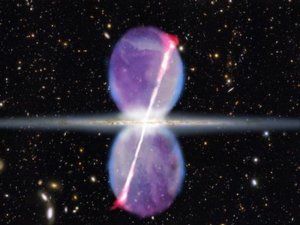
Credit NASA Goddard
At the time, scientists said they had no idea what was actually causing these gamma-ray bubbles. Even the person who found them said that it kind of just confuses everything. This is because mainstream scientists were not actually expecting to find such powerful emissions seeming to come from the central black hole of our home galaxy.
More bubbles found – X-rays this time
To make matters worse for mainstream scientists, people have now found some more bubbles but this time these are X-ray bubbles. These new findings have been published in the journal, Nature which reports how these new bubbles extend even further than the gamma-ray bubbles that were previously found.
This is very puzzling and is leading to headlines such as ‘Our galaxy is blowing enormous hot bubbles into space and no one knows why.’

Bubbles explained
But that’s not entirely true, because if you are aware of The Black Hole Principle, you’ll expect black holes to give off bipolar jets.
The Black Hole Principle says that light comes from infinity, through the dimensions to our dimension, then splits into matter and antimatter and combines again into light at that Perception Horizon that’s actually at the speed of light.
That combination into light is actually most commonly in the form of a Gamma-Ray burst. Because the Black Hole Principle occurs at every level of the universe, the type of light that is produced can vary.

The Black Hole Principle
Two poles of X-rays from fast-moving electrons
The ‘breathing’ process in the Black Hole Principle that creates matter and antimatter occurs just below the speed of light. The matter that is produced can often be in the form of electrons. This means that the electrons have only just ‘slowed down’ to below the speed of light.
This is what we see through our telescopes; we see fast-streaming electrons coming from black holes and indeed from every level of the universe. We even see this happening in the thunderstorms above our heads. Fast-moving electrons can result in X-rays.
The Black Hole Principle gives off a pattern of intermittent gamma rays and X-rays as the black hole is ‘breathing’ in and out. These emissions often take the form of two jets at 180 degrees to each other.
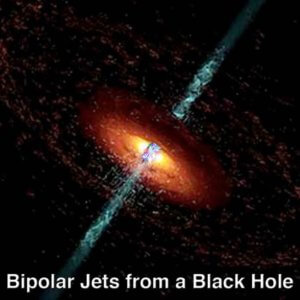
Bubbles predicted
And so that’s why, with knowledge of The Black Hole Principle, we would expect there to be two poles of emissions either side of this galaxy. The bubbles are being created by the bipolar jets of gamma rays and X-rays, which are spiralling and rotating.
Bubbles have also been spotted around other objects such as stars. When you start looking, you can find many examples of bipolar jets and even bubbles around various structures in the universe.
So according to The Black Hole Principle, this is the explanation for why X-ray bubbles are appearing in the Milky Way.
What are your thoughts on why the galaxy is blowing bubbles? Please leave your comments below.

by Dr Manjir Samanta-Laughton | Dec 23, 2020 | Punk Science, Science
Auroras on a comet?
A lot us are familiar with the concept of Northern Lights and Southern Lights or Aurora Borealis and Australis as they are otherwise known. But why have scientists spotted an aurora on a comet? They are also seen around moons and other planets. Is the received wisdom on Auroras correct and what do they have in common with Black Holes? These are the questions we are asking today: what is the connection between auroras, comets and black holes?
A spectacular light show
You may be familiar with the concept of the Northern Lights which are spectacular changing colours that are sometimes seen in the sky in countries close to the North pole.
We are told that this spectacular light show actually has its origins with the sun as the solar wind, consisting of fast-moving charged particles, interacts with the magnetosphere of our planet causing various elements in the Earth’s atmosphere to create the colours that we see.
And for many years, we have accepted this explanation. Except as space exploration continues, we find some anomalies that don’t fit this theory. Auroras are seen on planets that we previously supposed were not able to have them. Jupiter has an aurora that is deemed too powerful for this usual explanation.
And in 2020 scientists discovered that even comets have auroras! This particular aurora was in the ultraviolet aspect of the spectrum so invisible to us.
But it leaves us with the question; how is it possible that something as small as a comet can generate a magnetic field large enough to interact with the solar wind and generate an aurora? The same question arises when we find auroras on distant moons too.
What exactly is going on?
Northern and Southern Lights pulse at the same time
I find it really intriguing that the northern and southern hemispheres on the earth both have these auroras at the same time – they are known as the Aurora Borealis and Aurora Australis respectively.
Actually, rather than coming from the outside in as we would expect particles from the sun to do, the charged particles go from the middle to the poles and you see both the northern and southern hemisphere light up at the same time. Not everyone mentions this and most of the diagrams show the particles going the other way.
In other words, the charged particles that create auroras on the Earth are similar to bipolar jets that we see around black holes.

Even though they are supposed to be created by different mechanisms, we see auroras around planets and moons and they consist of fast-moving charged particles.
A new theory of Auroras – they are bipolar jets!
I think that auroras are an expression of The Black Hole Principle: the same mechanism is happening in black holes in space as on the earth and also many bodies throughout space as well.
So you have these poles of charged particles that are going from the centre to either side, going to the north and the south poles of the earth.
The fast-moving charged particles, such as electrons, are creating these northern and southern light shows that we see with the interactions with the elements of the atmosphere.
But it’s not the just the solar wind interaction, it’s the interior of Earth or whichever planetary body, whether that be a moon or a comet, Jupiter or anything else that we’re finding that has auroras, it’s all the same sort of mechanism.
If we put it that way, then we’re looking at auroras are caused by bipolar jets of fast-moving charged particles similar to those found in black holes.
The Black Hole Principle and Auroras
We can see auroras as an expression of the Black Hole Principle. That’s what I think is also happening with the auroras that we’re seeing around comets.
We know that black holes create jets of fast-moving electrons due to The Black Hole Principle. These are powerful and intermittent and often are emitted in jets.

The Black Hole Principle
I think the same mechanism that creates auroras around comets is actually creating auroras at every single level, be it Jupiter or the Earth or moons. It‘s these bipolar jets that we see in black holes that are creating the auroras around planets and various bodies.
I hope you found this article and TV episode on Auroras, Comets and Black Holes interesting. Please leave your comments below and let me know what you think.

by Dr Manjir Samanta-Laughton | Aug 27, 2020 | Paradigm Revolution, Punk Science, Science
Ultraviolet spiral mystery
Scientists have recently discovered pulses and spirals of Ultraviolet light on the South Pole of Mars. Although they have convinced themselves they understand the chemical reason for these pulses of UV light, they do not understand why there is a spiral shape to them.
Can the Black Hole Principle come to the rescue and solve the mystery of Spirals on Mars?
Spirals on Mars
In August 2020 reports were published that spirals of light have been seen on the South Pole of Mars. These were in the Ultraviolet spectrum so not visible to the naked eye.
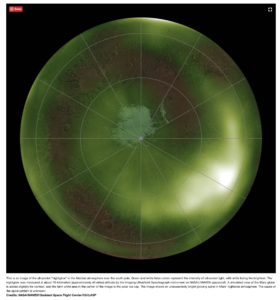
Spirals in Nature Credit: NASA
Mars also displays large pulsating areas which do seem to have a pattern to them according to to the time of day and even the seasons.
Although scientists think they have an explanation for the chemical composition of these pulses, they can’t explain their spiral pattern.
North Pole Mars Mystery
These recent spirals were seen around the South Pole of Mars but spirals have also been seen in the ice around the North Pole of Mars.
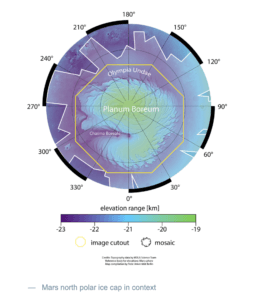
Spirals on Mars in the ice. Credit: MOLA team, NASA
As you might be aware spiral patterns are common in nature. There seems to be a fundamental mathematical pattern and geometry to the universe.

Spiral in Ferns
The behaviour of Mars all makes sense when you understand the Black Hole Principle and that the same pattern that occurs in black holes – bipolar jets in a spiral pattern are also happening on Mars and other structures including the Earth.

Spirals in Nature
We would expect such geometry to be seen on Mars as it will display the same patterns as larger black holes in the centres of galaxies.
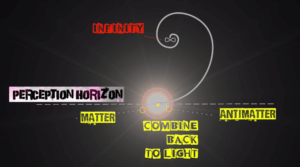
The Black Hole Principle
Conclusion
So it seems that the mystery of the Spirals on Mars is solved. If you understand The Black Hole Principle, you would expect to see spiral geometry on various bodies in space.

by Dr Manjir Samanta-Laughton | Jul 29, 2020 | Paradigm Revolution, Punk Science, Science
Is a black hole winking at us?
A Galaxy named 1ES 1927+654 became the object of attention for astronomers when it went through a 40-fold increase in brightness in March 2018.
They started discussing ‘winking black holes’. In this article, we discuss what is meant by that and what is really going on.
Ordinary no more?
What was thought to be an ordinary black hole at the centre of a galaxy was surprising scientists who turned their telescopes to study it further.
After that initial brightening, the Black Hole then dimmed, getting 10,000 times less bright in less than a year. It has since become brighter again. Hence the idea that it is winking.
Why so fast?
Current orthodox scientists believe that such changes should happen over thousands of years – but this black hole changed by a factor of 100 over the course of eight hours.
One of the foremost theories for what is going on is that a star has collided with the region around the black hole.
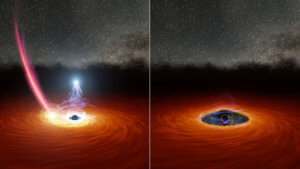
© NASA/JPL Caltech
Mainstream Scientists believe that a star colliding with the area around a black hole is causing it to ‘wink’.
Mystery Solved
However, by understanding, The Black Hole Principle, the mystery is solved. This predicts that the material ejected from the black hole fluctuates in an unpredictable pattern

The Black Hole Principle
We don’t need to evoke any violent or weird situations to explain this. Already mainstream scientists have told us about the amazing abilities of black holes to burp and gobble and they are now saying that they can wink.
It’s simply not necessary if you understand the black hole ‘winking’ as a natural consequence of the process at the edge of our reality.

by Dr Manjir Samanta-Laughton | Jun 17, 2020 | Punk Science, Science
Fast Radio bursts are one of the biggest mysteries in science today.
You may have heard of them because scientists are so stumped as to what is causing them that they are inventing all sorts of theories. Even that they could be alien communications!
So that’s what we are looking at in this episode of Punk Science TV.
An unexpected signal
In 2007 a scientist named Duncan Lorimer was looking over old data from the 1990s for new insights on pulsars when his student found a huge spike that everybody else had missed.
It was a burst of radio waves that had so much power in a short time that it would have taken the equivalent of all the energy of the solar system to produce them.
It wasn’t very certain if they were an artefact or not but after a while, scientists were finding more of these Fast Radio Bursts or FRBs and they are one of the biggest mysteries of space.
Characteristics of FRBs
What we know about FRBs
1. They emit huge amounts of energy in a short time – we are talking about thousands of a second in some cases.
2. They are coming from various places in the universe including our own galaxy.
3. They can sometimes repeat themselves after days or even hours.
Sometimes the source becomes quiet and we haven’t seen them repeat yet.
4. FRBs come in different strengths.
Alien Radio?
Explanations that have been put forward have included everything from alien communication to neutron stars colliding. We also have a favourite – they are being emitted from objects called Magnetars which are like neutron stars with strong magnetic fields.
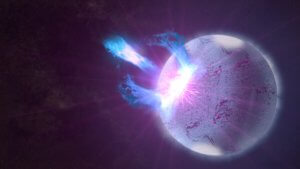
NASA’s Goddard Space Flight Center/S. Wiessinger
(And let’s not forget – these are made-up objects anyway to try and explain the effects we see in space! We haven’t actually seen them directly.)
Chasing the Gamma Rays to the Black Hole
Well, we are now tracking the source of the FRBs and have found that Gamma Ray bursts and X-rays are found in the same area at around the same time.
These are barn door characteristics of The Black Hole Principle.
1. You have the power emitted in a short amount of time, much more than can be explained easily. That’s because the energy is entering into our dimension from infinity.
2. The seemingly random patterns – emission over seconds, hours, days, months or even years can be possible.
It’s the breathing process of the black hole principle that can seem random to us.
3. FRBs are coming from all over space which would be expected as BHP is fractal in nature.
4. And they are associated with gamma-ray bursts and X-rays which I have long spoken about as the consequence of the antimatter, matter and light cycle at the edge of the black hole.

The Black Hole Principle
There are lots of types of energy emitted by BHP and this includes microwaves and radio waves.
Easy and Effortless
You don’t need any weird explanation for FRB. The universe is effortless. It breathes at every level.
So does this mean there are no aliens in space? No! But you don’t need to evoke aliens to explain FRBs when you understand the Black Hole Principle. It all becomes easy.
What do you think? Have FRBs been solved? Leave a comment below.


















